Re-presenting war: the Somme Heritage Centre (3:1)
Published in 1913, 20th-century / Contemporary History, Features, Issue 1 (Spring 1995), Northern Ireland 1920 - present, Revolutionary Period 1912-23, Volume 3David Officer
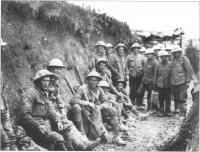
A ration party of the Royal Irish Rifles resting in a communications trench at the Somme, July 1916.
Historians of Ireland regularly harp on about the often blunt and crude forms in which the past is mobilised by contemporary interests. However, historians themselves pay scant attention to the forms, methods and media through which the transmission of a historical consciousness is effected. It is inadaquate to describe such complex processes as the simple reproduction of traditional practices or the outcome of the human faculty of memory. What is ‘traditional’ and what is ‘remembered’ is constantly being remade in the present. The telling anecdote or resort to the crude notion of a persistent ‘folk memory’ can never be an adequate substitute for a disclosure of the various ways through which an individual, group, or society makes sense of the past. Furthermore, there is an academic tendency to concentrate on the remnants of ‘high culture’ which are presumed to give privileged access to the past. Such an approach neglects the widespread and popular forms through which the relationship between memory and identity is asserted.
One way of rectifying this oversight is to consider the variety of sites which have become a focus for the re-imagination of the past. Museums and heritage centres are the most obvious examples, the places where most public history is now both produced and consumed. Though the professional historian can contribute to the historical narrative at the centre of these sites, other factors are at play. The heritage centre usually operates as a commercial concern; it must provide instruction as well as entertainment; it must connect with basic elements of a familiar story yet say something more than is commonly known; and it must generate an air of authenticity despite often limited access to original artefacts or concrete reference points. In Northern Ireland, in addition, the heritage centre has to contend with the political ramifications of elevating any particular aspect of the past to the exclusion of something, or someone, else.
36th (Ulster) Division
The Somme Heritage Centre was built between Newtownards and Bangor and opened to the public in April 1994. Like many similar sites it exemplifies these pressures and tensions but manages to effectively negotiate some of the more difficult problems which a project of this sort invites. The flagship of The Somme Association, its primary mission is to offer a series of explanatory representations of the events leading up to the First World War and with specific reference to the fate which befell the 36th (Ulster) Division on the l July 1916.
What is immediately apparent to the visitor entering the large and sparsely furnished entrance lobby is the religious aura which has enveloped the events remembered here. The bare stone floor, the large photo mural of the Ulster Tower at Theipval, the biblical inscription from the Gospel of St John—’Greater love hath no man than this, that a man lays down his life for his friends’—which is located above the main wall. The presentation of three display cabinets containing personal artefacts, Flanders poppies and the soil from foreign battlefields also help to establish this as a place of solemn remembrance. In this context they act as a frame within which the presentation of the past is effected and leave little room for doubt that important political and moral issues are at stake.
The visitor is guided into the main exhibition area through a corridor which presents a chronological regression from the 1990s to the year 1912. Events both parochial and global, cultural and political jostle for attention to the calculated effect of inducing an imaginative departure from the present. Each step taken around the centre is done in an escorted group which has distinct advantages over the unstructured and atomised experience of museum visiting. The guide can offer to mediate between the exhibit and the viewer, answering questions which the material on display might prompt but is itself unable to reveal. This process also creates an opportunity for communication amongst the group as a whole as they trade historical detail and those elements of a personal biography which intersect with the public history on view.
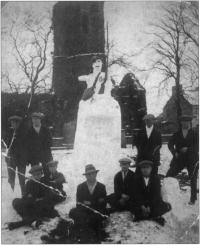
This snow memorial inscribed ‘Lest we forget’ was built by veterans on Newtownards green in the 1920s in order to shame the local council into erecting a memorial to honour the fallen.
Protestant preacher
The next stage of the exhibition offers a reconstruction of a village square in rural Ulster just before August 1914. Dominating this scene is the effigy of a Protestant preacher in a declamatory stance, bible in hand and from whom issues forth a commentary on the political crisis in Ireland prior to the war. As the lights dim attention is not only directed towards this centre of attraction but also to a series of projected images of important moments and personalities of the period. It would be easy to suggest that the words put in the mouth of the itinerant preacher represents a partial evaluation of a highly charged series of events. However, that objection is forestalled by the particular context within which it is voiced. This is an imaginative way of handling what was always going to be a difficult problem. Rather than presenting an authoritative commentary which aims to convey the impression of judicious distance the information is presented in the vernacular language of the time. Clearly emanating from a decidedly interested party the monologue is laced with turns of phrase which leave little doubt as to the partiality of the source. ‘Rome Rule or Home Rule’, an emotive appraisal of the signing of the Covenant which incorporates the sentiment that ‘when you sign your name in blood you are made’ resonate in the ears. Finally, having traced the emergence of the Ulster Volunteer Force and the Irish Volunteers, the sense of foreboding at the time is articulated—’I see nothing but the presence of darkness, shadows, we shall have once more to assert the manhood of our race’. For some visitors this presentation may
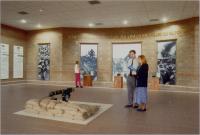
‘Greater love hath no man then this, that a man lays down his life for his friends’ (Peter Harvey)
fail to convey the information which its designers wish to do through this strategy. These sentiments and the way in which they are expressed still carry a contemporary ring. The preacher still plays an important part in the politics of the North and can be perceived to remain a threat to the interests of others. As a result the content of what is communicated here may become lost because of a resistance to the form in which it is articulated.
Recruiting sergeant
Joined by a guide dressed as a recruiting sergeant the next stage traces the process through which the ordinary citizen is transformed into a soldier. As a tape of marching songs plays in the background the visitor is ushered into a mock-up of a recruiting office surrounded by a series of
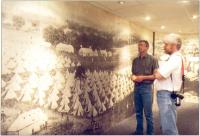 enlarged photographs of the bureaucratic process through which the army processed its human material. Stripped, measured and examined, these human bodies on display already have something of the pallor of death about them. From the shipyards and the farms, the offices and the ranks of the unemployed, the outward signs of civilian life are shed and the regimented order of military life envelops them. The poignancy of these images is reinforced by the viewer’s inability to approach this material without being aware of the fate which was likely to befall those photographed.
enlarged photographs of the bureaucratic process through which the army processed its human material. Stripped, measured and examined, these human bodies on display already have something of the pallor of death about them. From the shipyards and the farms, the offices and the ranks of the unemployed, the outward signs of civilian life are shed and the regimented order of military life envelops them. The poignancy of these images is reinforced by the viewer’s inability to approach this material without being aware of the fate which was likely to befall those photographed.
The display next focuses on the progress of the Ulster Division from a military camp on the Clandeboye estate, its departure from Belfast and relocation in France. A familiar landscape is perceivable, recruits passing the City Hall in Belfast and the famous profile of Helen’s Tower above the training camp outside Newtownards. Since rarely do the photographic images bear captions the viewer is reliant on the guide to situate the images presented. Again this facilitates a collective experience as the group exchanges knowledge of the period and jointly reflects on the same point of reference. This situation also provides an opportunity for the guide to pick out telling detail or allude to the contrived nature of the composition or indicate other layers of meaning which the photographs contain.
The rest of the exhibition space is devoted to photographs of the training process in France—the preparation for battle. There is also some attempt to illustrate the wider context within which the war was fought. A short video presentation outlines the high politics of the period which alludes to the competition between the major European powers and the chain reaction which followed the assassination of Archduke Ferdinand. The recruitment of soldiers into Irish regiments, the role of John Redmond in encouraging his nationalist supporters to sign up, along with the part played by the predominantly Catholic 10th Irish Division at Gallipoli breaks from the general concentration on the Ulster Division.
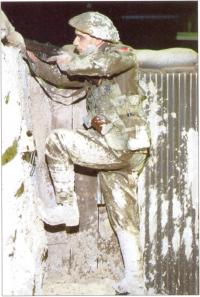 Trenches
Trenches
At the heart of the Somme Heritage Centre is an attempt to approximate the experience of life in the trenches through a major installation which takes the form of a section of the front line on the first day of July, 1916. The ante-room to this area is a mock-up of a billet hut where for the first time the visitor comes into contact with authentic artefacts from the period. The detritus of war litters the display cabinets—shells, anti-personnel mines, helmets and mess tins.
From here the group is taken by a guide dressed as a private into a darkened, cavernous room to the sound of gun fire. Following a winding track through the pit of a trench the visitor passes a series of tableaux, a soldier peers over the parapet of a command bunker here and a dug-out there. The path terminates outside the trench system with a view over No-Man’s-Land—shell holes, barbed wire and the outline of a dead or dying human form punctuate an earthy morass only relieved by the occasional poppy.
On screens above this scene images of war are projected and accompanied by a dialogue between a number of soldiers whose accents are both northern Irish and working class. A commentator sets the scene and puts the battle of the Somme in the context of the war as a whole. Other recorded dialogues presented come from various sources. A statement by the commanding officer before the assault, the sentiments of the common soldier thinking of home and reports of the experience of being bombarded, shot at and stranded between the two sides. Accompanied by a series of photographic montages the stories attempt to report the course of the attack and the emotional and subjective responses to the cataclysm that engulfed the troops. While occasionally this is tinged with bathos, such as a description of eating an Ulster fry on the morning of the attack, much of the dialogue undermines the rendition of the event as simply heroic and gives voice to the sheer brutality of the struggle. Represented here is something of the fog of war such as the difficulty of picking your way through craters and over lifeless bodies which cannot be distinguished as that of Ulstermen or Germans.
Memorialising function
While the concluding commentary stresses the involvement of other regiments and soldiers from all over Ireland it also attempts to give meaning to the considerable loss of life during the battle by alluding to the courage and dash of the Irish which aided the eventual victory of the Allied forces in a grand war of attrition. The description of battle and the course of events of which it was a part gives way to the imputed significance of the war and the memorialising function of the heritage centre once again asserts itself. With the conclusion of the commentary ringing in our ears—’The war left its legacy on the land as an indelible reminder, fixed in people’s minds for ever and marked by memorials to ensure that we should never forget. We were told that the war to end all wars had been fought’—images of monuments dominate the screen and a shaft of light picks out poppies from the rest of the battle scene.
Exiting this area you pass through large displays of the outcome of the official memorialising process—rank upon rank of individual grave marks stretch into the distance and the Theipval Tower in the French countryside. These attempts to give permanent expression to the human consequences of the war were a genuinely original departure at the time. The scale of monument building both at home and on the former battlefields had never been witnessed before. Naming names and recording the part played by common soldiers in part expressed a new sensibility born out of total war and is taken a stage further by the Somme Heritage Centre. In the final room computer technology is employed to similar effect through a database which allows access to the name and rank of all those in the 10th, 16th and 36th Divisions.
The narrative which carries the visitor from the present and back to the early part of this century and forward again to the Somme battle is conveyed through artefacts and images, sounds and reconstructed scenes: but the impetus for taking such a journey is predicated upon the moral necessity of remembering the dead. In this it is no different from heritage centres elsewhere which focus on past events of cataclysmic proportions be it the Famine Museum in Strokestown, County Roscommon or the Holocaust Museum in Washington DC. These centres must negotiate the gap between the events themselves and representations of them.
Difficulties of representation
Published in 1916, Henri Barbusse’s novel Under Fire presents an exchange between a group of soldiers which highlights this intractable problem which was anticipated by the participants themselves.
It’ll be no good telling about it, eh? They wouldn’t believe you; not out of malice or pulling your leg, but because they couldn’t… No one can know it. Only us. No, not even us! Someone cried. That’s what I say too. We shall forget—we’re forgetting already, my boy!
What remains? The last survivors of the Great War are in their nineties so it falls to those who have no direct experience of the events themselves to re-present what happened. The Somme Heritage Centre has based some of its reconstructions on the oral testimony of the survivor. Leslie Bell, now in his ninety-eighth year, provided the evidence of the itinerant preacher who spread both the gospel and the news in his home village of Moneymore and recalled dialogue from the Somme engagement which figures in the main installation.
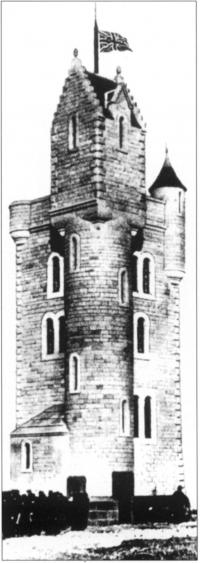
The Ulster Tower, Thiepval – Official memorial of the 36th Division at the Somme.
Photographic evidence
The authenticity of the rest of the display is contingent upon a small range of artefacts. However, the veracity of the presentation is primarily secured through the use of photographic evidence. This raises a range of problems related to their original production. The stock of images available was produced in circumstances of heavy censorship where the press where rarely allowed near the front, an area of work confined to the officially sanctioned photographer and within which troops were strongly discouraged from recording their own situation. Images of combat near the front-line and the Allied war dead either went unrecorded or never made it into print. If the stock of images is so limited then an exhibition largely dependent on this source is partly compromised. However, the sometimes sceptical attitude of the guides to the photographic material at least suggests an awareness of this problem.
Political issues
Clearly much thought has been given to the ways in which the participation of the Ulster Division in the battle of the Somme can be depicted in such a way as not to exclude the part played by Irish nationalists in the Allied armies. The relationship between that Division and the original UVF has lent itself to highly politicised renditions of its progress and fate, with important contemporary consequences. In response, throughout the exhibition ample acknowledgement is given of the part played by Irish soldiers from all parts of the country, of varying political and religious persuasion in the prosecution of this struggle. In a sense there is something of an overcompensation in this regard since the increasing opposition to participation in the war effort by many people in Ireland and the militant opposition to British rule exemplified by the Easter Rising are made invisible in this account. A fundamental tension is at play here which suggests the difficulty of this site both having a memorialising function and simultaneously trying to encapsulate the vital contours of the period. To admit a vital aspect of the period which at the very least suggests conditional support for the war effort threatens to undermine the assertion of a universal and consensual basis upon which remembrance is most effectively pursued in the present.
Thoughtful and conscientious
To recognise this tension at work is not to invalidate the project or suggest that the aspirations which it jointly pursues are simply incompatible. The taut relationships between them are not only written into the very texture of the exhibition but have appeared in a multitude of ways through which people have attempted to come to terms with the Great War. The brute fact of slaughter was given meaning and purpose for those who survived and those who grieved by adopting an idiom of remembrance which stressed the sacrificial nature of this mass death. Since then this process has not been displaced but modified through time. In the South public remembrance was driven to the periphery as it was seen by nationalists as an unfortunate if not distasteful reminder that so many Irishmen died fighting for the British cause. In the North the new state elevated the part played by the Ulsterman in defence of Britain as the hallmark of loyalty. The facts of war, its remembrance and the forms through which it finds adequate representation have and remain highly charged. This heritage centre has itself become part of that process but those who have contributed to its development have done so in a thoughtful and conscientious way, negotiating many of the difficult problems a project of this sort was always going to confront.
David Officer is a postgraduate in politics at Queen’s University, Belfast.
















